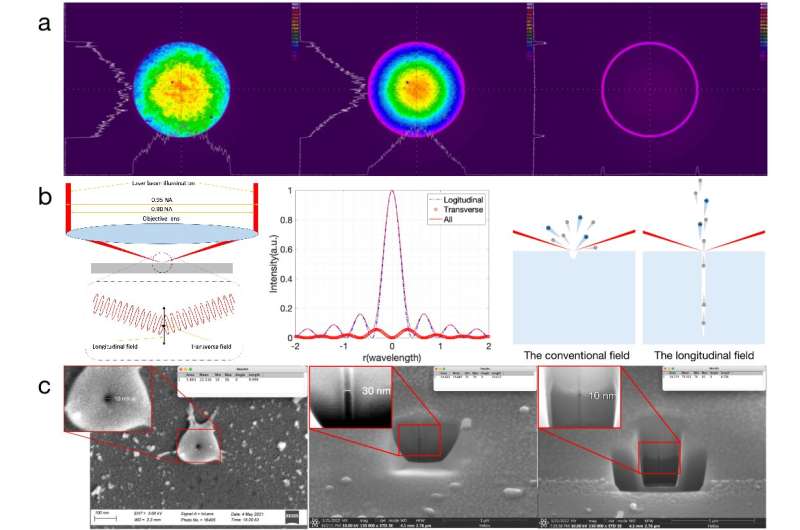Longitudinal field laser processing enabling high aspect ratio 10 nm features produced in sapphire

Toward the end of the 19th century, Abbe and Rayleigh formulated the principles of optical diffraction that limits the resolution of optical instruments in the far-field where the distance between the target and the optical element is far greater than the optical wavelength.
These principles remained unchallenged for over a century until new developments in optical technologies opened up new avenues for breaking the diffraction limit. One such technique uses focused annular amplitude collimated laser beams with a radial polarization, so that opposite direction plane waves propagate towards the same focal point and cause constructive interference in the optical axis, leading to a symmetrical focal spot where all-the electric fields are oriented in the longitudinal direction, parallel to the optical axis.
Although a number of prior investigations attempted to demonstrate the possibility to break the optical diffraction limit by using the so-called longitudinal field, the purity of these fields has never been sufficiently high to achieve the best processing resolutions. On the one hand, the spherical aberration of a high NA lens focusing is difficult to overcome by using standard optical lenses. On the other, a high-quality annular collimated beam with a very small width and a uniform distribution is required, which is also difficult to realize by only blocking the central area of the beam. If the focused laser beam is a mixture of longitudinal and transverse fields, the processing resolution is reduced.
In a new paper published in Light: Science & Applications, a team of scientists led by Professor Lin Li and Dr. Olivier Allegre from the Laser Processing Research Center, The University of Manchester, U.K., has developed a novel method to experimentally demonstrate a longitudinal femtosecond laser field (i.e., parallel to the optical axis) with an unprecedented high purity (94.7%) and its interactions with polished silicon, copper, and sapphire.
The new optical setup is developed using an 800 nm wavelength femtosecond laser source and a pair of spatial light modulators (SLMs) in a double 4-f optical arrangement to tailor the laser light fields and realize high-quality and uniform beam shaping to correct the spherical aberration of the 0.95 NA objective lens. The experiments involved focusing the beam first using an aplanatic 0.75 NA lens to confirm the presence of the longitudinal fields, and then using a 0.95 NA lens to further understand the characteristics of the focused longitudinal fields and their effects on laser materials processing.
A number of polarization states, beam intensity distribution and wavefront ablation profiles were investigated and the results were compared with theoretical models of the longitudinal field. Material processing with a resolution (10 nm, i.e., l/80) well beyond the far-field diffraction limit at the infrared laser wavelength of 800 nm was demonstrated on polished sapphire in air.
Dr. Zhaoqing Li said, "To generate high purity longitudinal field, the laser beam needs to be shaped into a high quality annular beam. We firstly shaped the original collimated Gaussian into a perfect Gaussian beam, and then converted it to a thin annular beam, by using a spatial light modulator (SLM)."
"Before focusing the annular laser beam with radial polarization with a 0.95 NA objective lens, the spherical aberration needs to be precisely corrected, to make sure the laser beam is focused into a same plane. We realized it by using another spatial light modulator (SLM), so we could achieve the high-quality longitudinal field, with a purity of up to 94.7%."
"By focusing the longitudinal field on sapphire, holes with a diameter as small as 10 nm could be created, which is much smaller than the previously published results based on strong nonlinear laser materials interaction processes."
"To verify the cross-section characteristics of these tiny holes, focused ion beam (FIB) cross-sectioning was conducted. For a 30 nm diameter hole, the depth was over 500 nm with a zero taper."
Dr. Olivier Allegre said, "The extremely small feature size and very high depth to width aspect ratio with parallel hole walls observed in this study could indicate that the material removal mechanism induced with the longitudinal field is fundamentally different from those induced with a transverse linear polarization. This phenomenon is rarely seen in laser materials processing at this scale with a single pulse."
"In the experimental results demonstrated in this paper, the electrical field is to the laser beam axis. The laser beam with the longitudinal field could behave somewhat like a particle accelerator and enable the electron (with negative charge) and ion (positive charge) to be ejected more effectively than in a standard Coulombic explosion. The very deep holes produced in our experiments show the possibility of electron acceleration and charge polarization in the holes for material removal."
Professor Lin Li said, "The significance of this research is the demonstration of super-resolution materials processing with an infrared laser beam, which breaks the optical diffraction limit in the far field, while most previous approaches are either based on costly extreme ultraviolet (EUV) laser wavelengths that operate within the optical diffraction limit, or on the use of near field optics that make the working distance too close to be practically useful. The very high aspect ratio of the laser processed features points out a new material removal mechanism."
More information: Zhaoqing Li et al, Realising high aspect ratio 10 nm feature size in laser materials processing in air at 800 nm wavelength in the far-field by creating a high purity longitudinal light field at focus, Light: Science & Applications (2022). DOI: 10.1038/s41377-022-00962-x
Journal information: Light: Science & Applications
Provided by Chinese Academy of Sciences





















